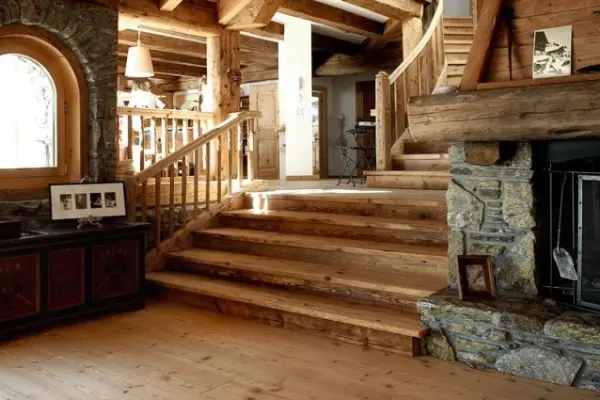Want to transform your home or apartment into a cozy Alpine retreat with the mysterious charm of mountain cottages? Chalet architecture is the perfect choice for those who value natural materials, nature-inspired aesthetics, and an atmosphere of tranquility. This authentic mountain style interior with massive wooden beams, stone masonry, and rustic elements creates a special feeling of security and comfort. The Swiss chalet harmoniously combines rustic style and functionality, offering practical solutions for modern interiors with Alpine character.
The mountain style in interior design has evolved over centuries from simple Alpine huts and shepherd's cabins where people sought protection from harsh weather conditions. Today, this cozy design has been adapted for modern chalets and even urban apartments, while maintaining its natural essence and the mystical atmosphere of ancient chalets. In this guide, you'll find specific advice on how to create a functional wooden interior in Alpine house style that will be not only beautiful but also convenient for everyday life, as well as information about the average price of chalet decor depending on the materials chosen.
Basic Principles of Chalet Style: What Works in Practice
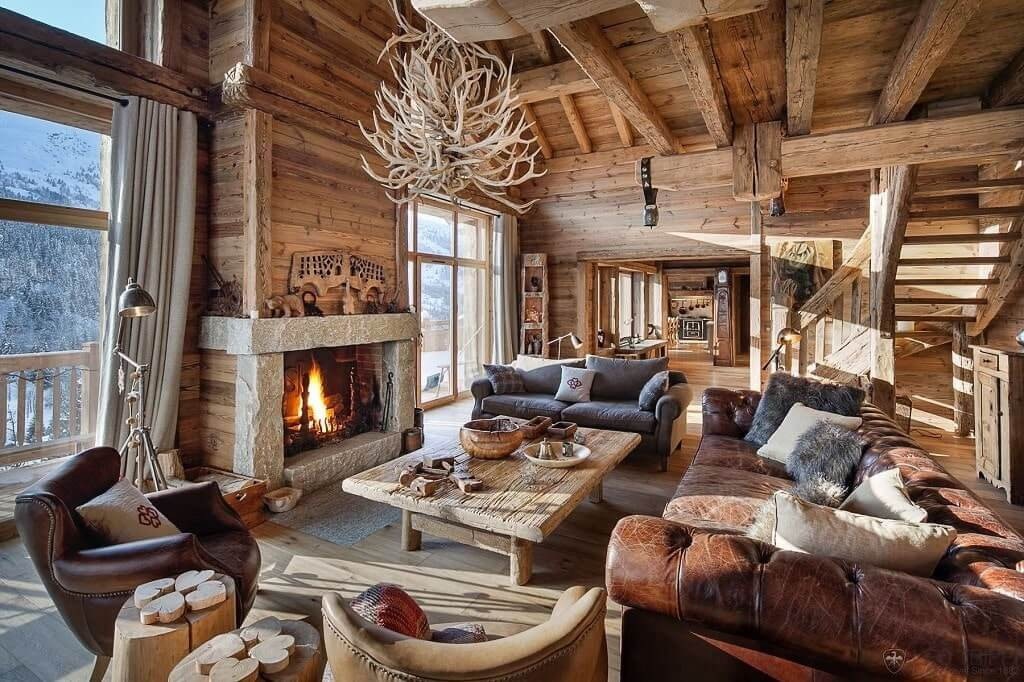 If you're planning to order a chalet design or create it yourself, it's important to understand the fundamental principles of this style. A modern chalet balances between simplicity and coziness, avoiding excessive decor in favor of functionality. Chalet architecture includes characteristic elements that create a recognizable appearance both outside and inside. Here's a practical approach to implementing this cozy design:
If you're planning to order a chalet design or create it yourself, it's important to understand the fundamental principles of this style. A modern chalet balances between simplicity and coziness, avoiding excessive decor in favor of functionality. Chalet architecture includes characteristic elements that create a recognizable appearance both outside and inside. Here's a practical approach to implementing this cozy design:
- Spatial solution: Open floor plan with zoning using levels, half-partitions, or furniture. This creates a sense of spaciousness while maintaining the functionality of each zone in the wooden interior.
- Materials: Choose only practical eco-friendly materials or their quality imitations. For flooring, solid wood boards with protective coating or porcelain tiles "wood-look" are suitable for areas with high humidity.
- Color scheme: Use no more than 3-4 main warm tones for the entire interior. Basic colors: brown, beige, gray, and white — create a harmonious atmosphere without visual overload.
- Lighting: Multi-level lighting with main, functional, and decorative light. Alpine style always requires warm light (2700-3000K), imitating natural lighting.
"When creating a chalet-style interior, the main thing is not to overdo the decor. It's better to choose a few signature elements — massive beams, stone masonry for the fireplace, quality wooden furniture — and build the design around them. This minimalist approach not only looks authentic but also significantly simplifies cleaning and home maintenance. When clients ask about the pros and cons of chalet houses, I always emphasize their timeless character and eco-friendliness," — advises interior designer Claudia Hines, who specializes in Alpine style.
An important practical advantage of Swiss chalets is their resistance to trends and fashion influences. By investing in quality materials and furniture, you create an interior that won't require chalet-style renovation in a few years, making this style economically advantageous in the long term, despite the initial cost. This fact is important to consider if you're interested in how much a chalet house costs during comprehensive design.
Step-by-Step Guide to Creating a Chalet-Style Interior
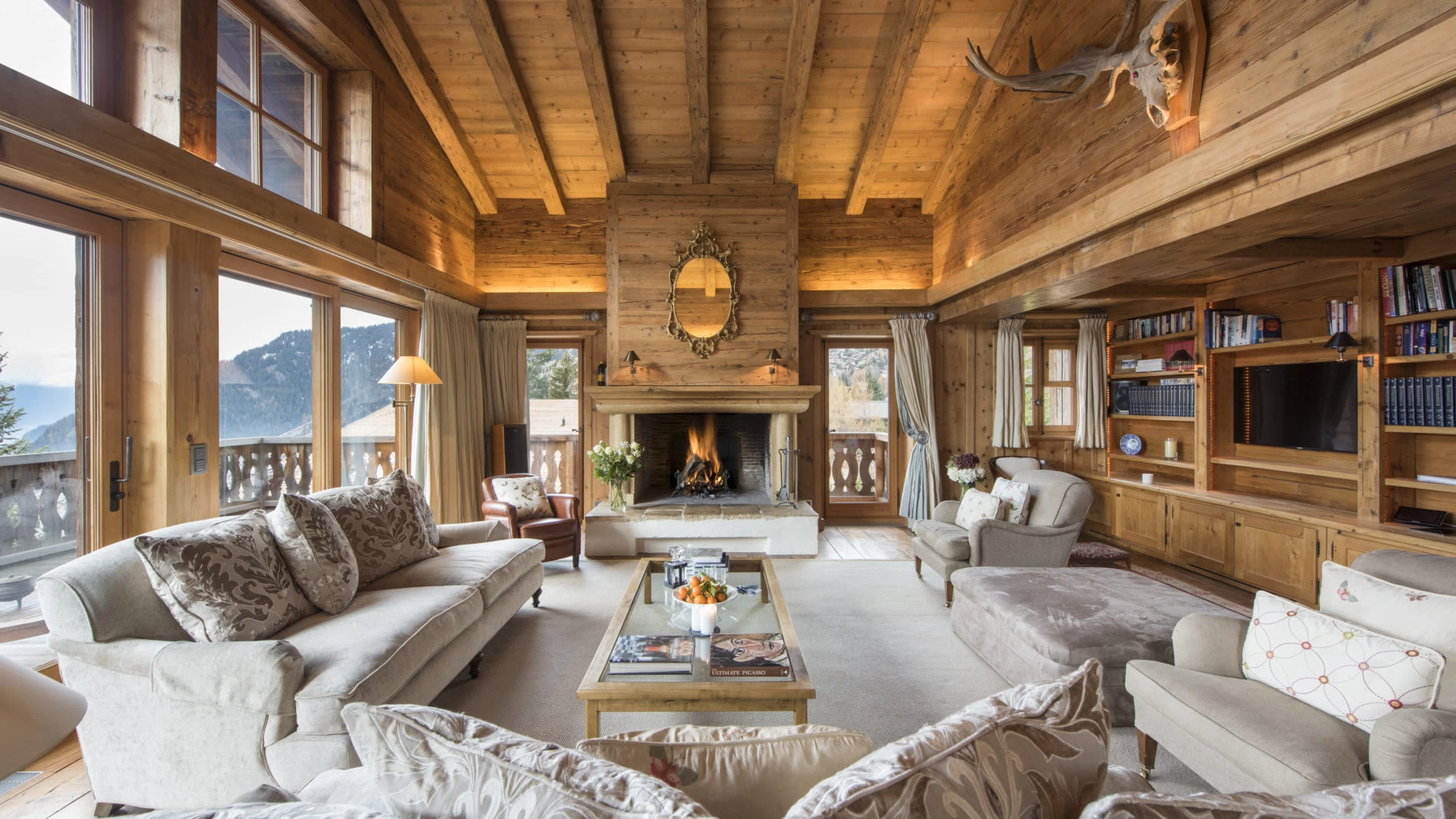 Creating a functional interior in mountain style may seem like a challenging task, but the right chalet house project will significantly simplify the process. A key role in the successful result is played by the fairy-tale atmosphere of Swiss cottages, which needs to be recreated. Here's a step-by-step action plan:
Creating a functional interior in mountain style may seem like a challenging task, but the right chalet house project will significantly simplify the process. A key role in the successful result is played by the fairy-tale atmosphere of Swiss cottages, which needs to be recreated. Here's a step-by-step action plan:
- Evaluate your space — identify architectural features that can be emphasized (high ceilings, panoramic windows) or concealed.
- Create the base — start with the finishing of walls, floor, and ceiling, using natural materials or their quality imitations. For a chalet stone facade, decorative panels with masonry imitation can be used.
- Install a focal element — a traditional fireplace, massive beam, or panoramic window with a view of nature will become the center of the Alpine house composition.
- Select the main furniture — it's better to start buying chalet furniture with large items (sofa, bed, dining table), choosing functional models with simple lines in the country-chic spirit.
- Add lighting — combine general light (chandelier or ceiling lights) with local (floor lamps, wall sconces, table lamps), using forged elements to add authenticity.
- Complement with textiles — use natural fabrics of various textures to create coziness and additional thermal insulation, not forgetting about animal hides in decor as a traditional element.
- Finish with chalet-style accessories — minimalistically add a few authentic items related to mountain themes to emphasize the magic of handcrafted details.
By following this plan, you'll be able to create a harmonious and practical interior, avoiding common mistakes such as overloaded decor or unbalanced use of materials. Reconstruction of an existing house into a chalet is also possible with the right approach to updating key elements.
Practical Solutions for Chalet-Style Finishing
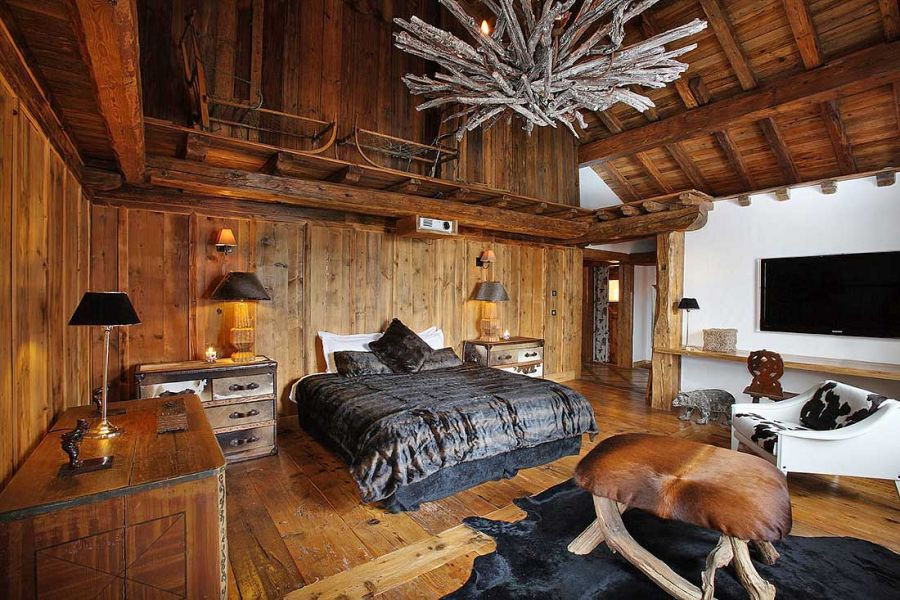 Choosing the right finishing materials for a chalet is a key factor in creating a durable and functional interior in Bavarian and Norwegian styles. Chalet construction requires special attention to the quality of materials used, as they determine not only the appearance but also the durability of the structure. Here are the most practical options for various surfaces:
Choosing the right finishing materials for a chalet is a key factor in creating a durable and functional interior in Bavarian and Norwegian styles. Chalet construction requires special attention to the quality of materials used, as they determine not only the appearance but also the durability of the structure. Here are the most practical options for various surfaces:
| Surface | Traditional Material | Modern Alternative | Practical Recommendations |
|---|---|---|---|
| Walls | Solid beam, tongue and groove | MDF panels with veneer, textured plaster | Combine wooden panels with painted surfaces for balance. In the bathroom and kitchen, use water-resistant materials. |
| Floor | Solid board, stone slabs | Engineered board, porcelain tiles with wood or stone texture | Choose materials with high wear resistance (class 33+) and protective coating. For the entrance area, provide tiles or stone. |
| Ceiling | Exposed wooden beams | Polyurethane false beams, painted ceiling with wooden accents | Decorative beams should look structurally logical. Use light shades for low ceilings. |
| Fireplace | Stone masonry, brick | Porcelain tiles with stone texture, decorative stone | Prefer materials with high heat resistance. Provide floor protection from sparks. |
| Windows | Wooden frames | PVC windows "wood-look" with high thermal insulation coefficient | Choose windows with double or triple glazing for better thermal insulation. If possible, install panoramic windows. |
| Doors | Solid wood | Veneered or laminated doors with natural wood imitation | Choose models with good sound insulation. Interior doors should visually match the wall finishing. |
| Staircase | Solid wooden construction | Combination of metal frame with wooden steps | Provide non-slip coating for steps and reliable handrails. The space under the stairs can be functionally used. |
This table will help you make an informed choice of finishing materials, balancing authenticity, practicality, and budget when building a chalet house. Modern alternatives are often more affordable, easier to maintain and install, but with the right selection, they don't compromise on aesthetics compared to traditional materials, preserving the soul depth of the rustic interior.
Ergonomic Furniture in Chalet Style
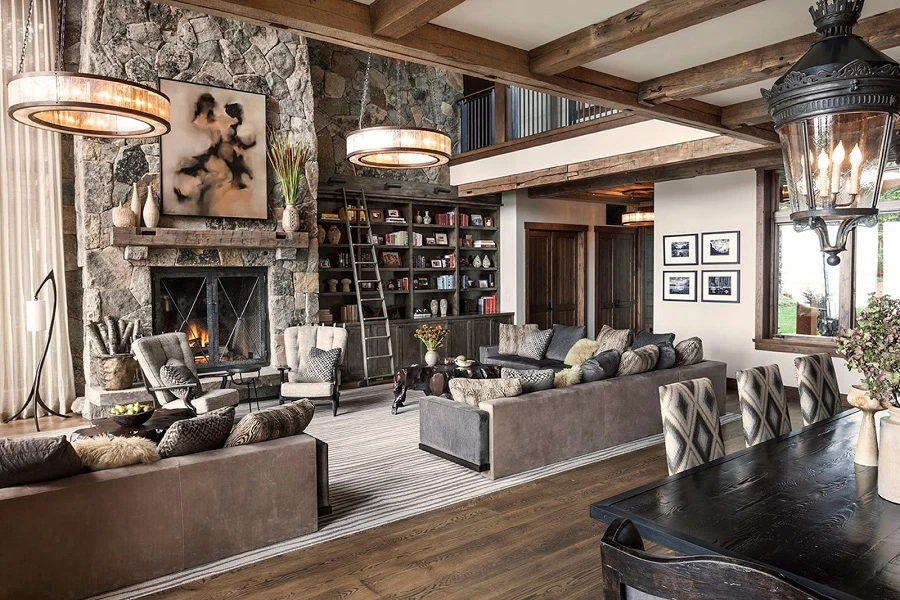 When choosing furniture for a chalet interior, it's important to find a balance between authentic appearance and modern functionality. Furniture should be not only stylish but also comfortable for everyday use, reflecting the authentic history of Alpine buildings in its design.
When choosing furniture for a chalet interior, it's important to find a balance between authentic appearance and modern functionality. Furniture should be not only stylish but also comfortable for everyday use, reflecting the authentic history of Alpine buildings in its design.
Here's a list of the most practical solutions for the main areas of an Alpine house in the country chalet spirit:
- Living room: Choose deep sofas with high backs and armrests, upholstered in natural leather or durable fabric with high wear resistance (from 30,000 Martindale cycles). Removable covers that can be cleaned are preferable.
- Kitchen: Kitchen sets made of solid wood or MDF with veneer, with protective coating against moisture and stains. Countertops made of quartz agglomerate or natural stone are more practical than wooden ones.
- Dining room: Massive furniture made of hardwood with protective coating. Chairs are better chosen with soft seats, upholstered in moisture-resistant fabric or leather, which adds a cozy atmosphere to the country house.
- Bedroom: Bed with a sturdy wooden frame and a quality orthopedic mattress. Bedside tables with drawers for storage.
- Storage system: Built-in wardrobes with "wood-look" facades, open shelves for decorative items, chests, and dressers for textiles and seasonal items — important elements for maintaining order in a rustic-style house.
For maximum comfort, pay attention to furniture ergonomics: seat height (40-45 cm), sofa depth (from 80 cm), comfortable backs and armrests. In small spaces, choose multifunctional furniture: sofa beds, transforming tables, poufs with storage space. When designing a chalet in an apartment, it's especially important to carefully select the scale of furniture.
"In my practice of chalet design, I always advise clients to invest in quality furniture made of rough wood. Such items not only create the right atmosphere but also serve for decades, acquiring a noble patina over time. This is especially true for the dining table — the center of family life in an Alpine house. A solid wood table can become a family heirloom, storing the histories of several generations. Today, many people are interested in whether it's possible to buy chalet furniture with delivery — yes, specialized companies offer this option," — says Jean-Michel Gautier, an Alpine interior designer with 30 years of experience.
Functional Lighting in Chalet Interior
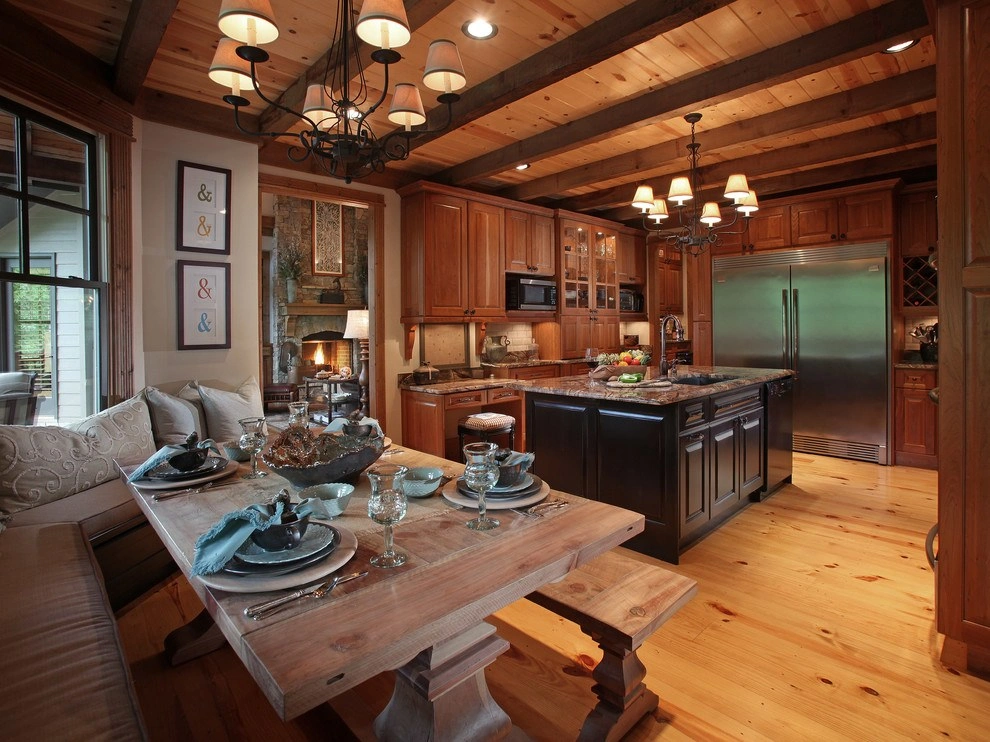 Properly organized lighting in mountain style serves both practical and decorative functions. Creating a multi-level lighting system will provide comfort at any time of day and emphasize the architectural features of the interior, such as high ceilings and textured plaster.
Properly organized lighting in mountain style serves both practical and decorative functions. Creating a multi-level lighting system will provide comfort at any time of day and emphasize the architectural features of the interior, such as high ceilings and textured plaster.
To create functional lighting in a country-chic interior, follow these recommendations:
- General lighting: Use massive chandeliers made of wood and forged elements in the center of main rooms. The optimal hanging height is 70-80 cm above the dining table, 2-2.5 m above the floor in the living room.
- Task lighting: In the kitchen area, install directional lights above work surfaces (illuminance 300-500 lux). In the office or workshop, provide a desk lamp with adjustable position.
- Accent lighting: Highlight architectural elements (beams, stone masonry) using recessed spotlights or LED strips in aluminum profiles.
- Decorative lighting: Complement the interior with wall sconces imitating candles or kerosene lamps, creating cozy light islands.
- Natural lighting: Maximize daylight through panoramic windows with views of mountain landscapes in the interior. For brightness control, use natural curtains made of linen or cotton.
Practical tip: install dimmers for brightness adjustment and use "smart" bulbs with the ability to change color temperature from warm (2700K) in the evening to neutral (4000K) for daytime activity. This solution combines traditional country chalet with modern comfort suitable for eco-friendly housing.
To create an authentic chalet atmosphere, consider installing wooden chandeliers with forged elements, which are a characteristic feature of Alpine style and create a special mood with subdued light.
Practical Solutions for Chalet-Style Fireplaces
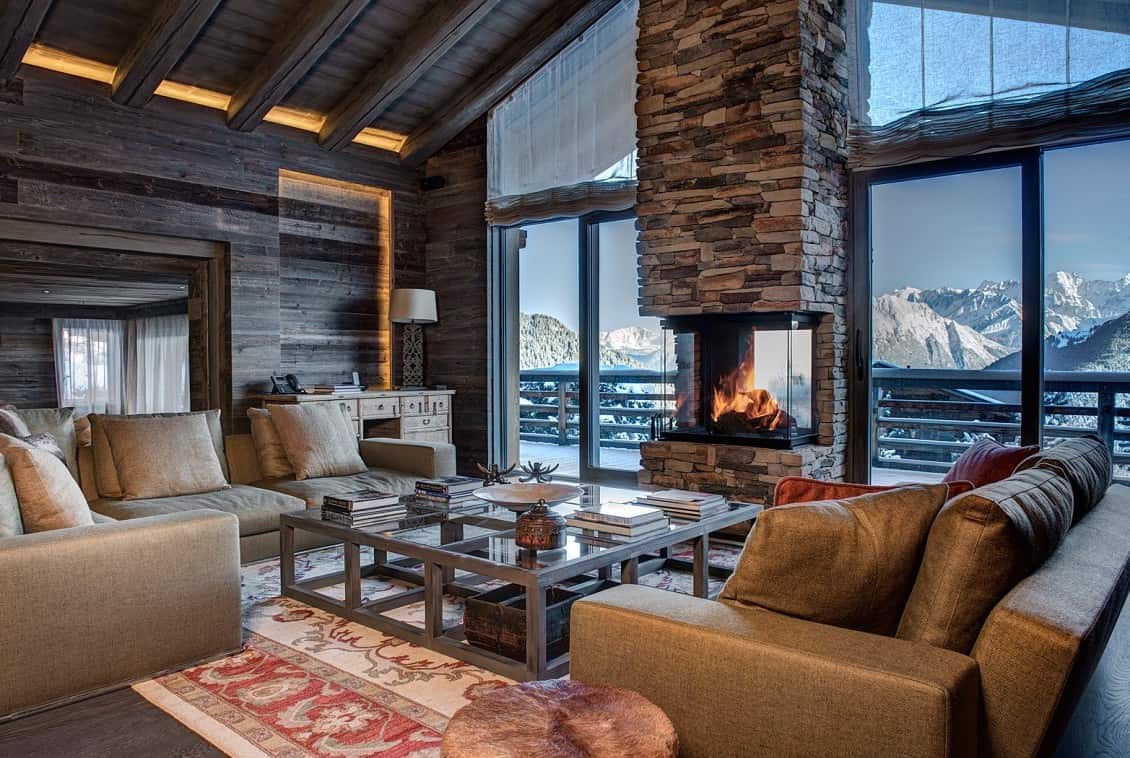 A traditional fireplace is the heart of any chalet, but its installation requires careful planning. Modern technologies offer various options suitable for different types of rooms and safety requirements. Chalet-style finishing is impossible without a properly designed hearth, creating the center of the composition.
A traditional fireplace is the heart of any chalet, but its installation requires careful planning. Modern technologies offer various options suitable for different types of rooms and safety requirements. Chalet-style finishing is impossible without a properly designed hearth, creating the center of the composition.
Comparison of fireplace types for chalet interior with mountain landscape harmony:
| Fireplace Type | Advantages | Disadvantages | Installation Features |
|---|---|---|---|
| Wood-burning fireplace | Authentic look and atmosphere, real heat and characteristic smell, doesn't depend on electricity | Requires regular cleaning, needs a chimney, high fire safety requirements | Professional design and installation required. The foundation must support the weight of the structure (from 500 kg). Permission is required for installation in apartment buildings. |
| Gas fireplace | Ease of use, no ash, adjustable power, realistic flame | Needs access to gas supply, requires ventilation, annual maintenance | Installation possible with direct or coaxial chimney. Professional connection and approval from gas services required. |
| Bio fireplace | Doesn't require a chimney, minimal installation requirements, real flame | Limited heat output, costs for biofuel, room ventilation needed | Can be installed almost anywhere. Important to maintain a safe distance from combustible materials (minimum 1 m). |
| Electric fireplace | Simple installation, safety, doesn't require special permits, adjustable operating modes | Depends on electricity, flame imitation not always realistic | Only requires access to an electrical outlet. Can be installed in a portal imitating stone or brick masonry. |
| Decorative portal with lighting | Maximum safety, no fuel costs, minimal maintenance | Absence of real fire and heat, purely decorative function | Can be made from any finishing materials. Lighting is implemented using LED strips or built-in lights. |
When choosing a fireplace type, consider not only aesthetic preferences but also practical aspects: the type of room, availability of technical capabilities for installation, safety requirements, and maintenance budget. For a chalet in an apartment, electric or bio fireplaces often become the optimal solution, while for country houses, all options can be considered, including installing a real fireplace in the interior.
Textiles in Chalet Interior: Practical Solutions
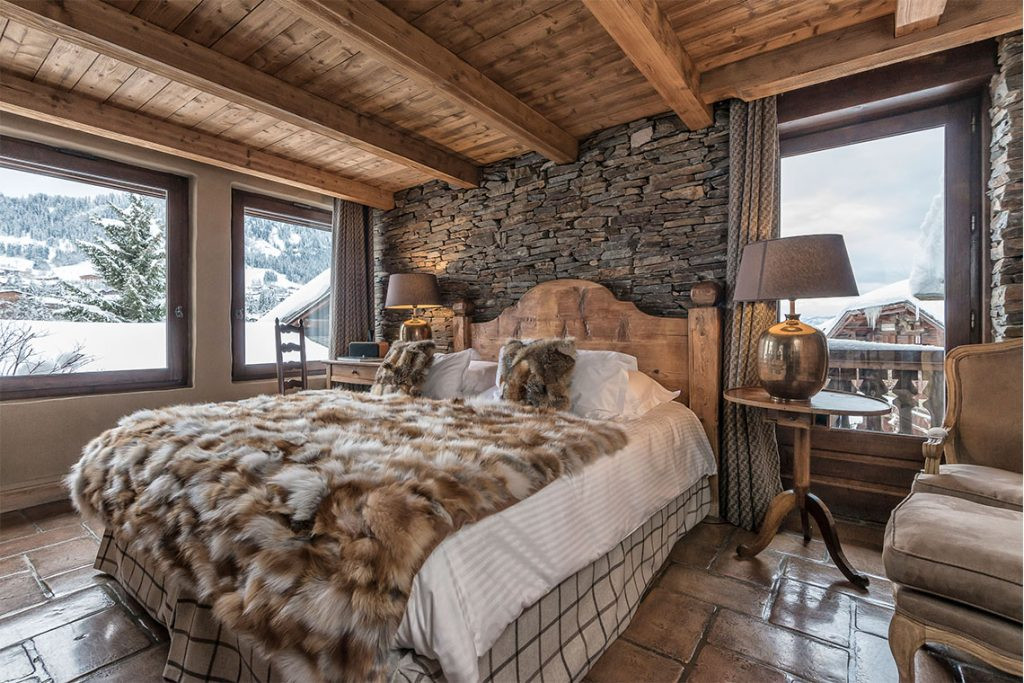 Textiles in a chalet play an important role in creating a comfortable interior, providing not only coziness but also additional thermal insulation. Alpine romance in design is largely created through properly selected fabrics. When choosing textiles, it's important to consider both aesthetic and practical aspects.
Textiles in a chalet play an important role in creating a comfortable interior, providing not only coziness but also additional thermal insulation. Alpine romance in design is largely created through properly selected fabrics. When choosing textiles, it's important to consider both aesthetic and practical aspects.
Recommendations for choosing functional textiles to recreate the unique microclimate of a chalet:
- Curtains and drapes: Choose dense fabrics (linen, wool, cotton) with thermal insulation properties. For bedrooms, consider double curtains: dense for darkening and tulle for diffused light.
- Carpets and floor coverings: Natural materials with high pile are preferable for thermal insulation. In areas with intense traffic, choose wear-resistant options with stain treatment.
- Furniture upholstery: For sofas and armchairs, durable fabrics (from 25,000 Martindale cycles) with water-repellent impregnation are optimal. Leather upholstery and suede look good visually but require special care.
- Decorative pillows and throws: Use different textures to create visual and tactile variety. Covers should be removable for washing.
- Bed linen: Natural fabrics with a density from 200 TC are preferable for durability. Flannel and molleton are suitable for the winter season, linen bedding for summer.
Practical advice: choose textiles in a neutral color scheme with traditional Alpine patterns (geometric ornaments, snowflakes, deer) as accents. This will allow you to easily update the interior by changing only the decorative elements. The ability to buy chalet decor in specialized stores significantly simplifies the decoration process.
"Textiles in a Swiss chalet should be not only beautiful but also functional. I always recommend clients invest in quality wool or cashmere throws that will warm on cold evenings and serve for decades. Avoid synthetic materials — they not only violate the authenticity of mountain style in the interior but are also static, which is especially noticeable in dry climates. Natural shades in design and natural fabrics create a healthy microclimate and only get better over time," — shares Emma Berger, a textile designer specializing in Alpine style.
Adapting Chalet Style for Urban Apartments
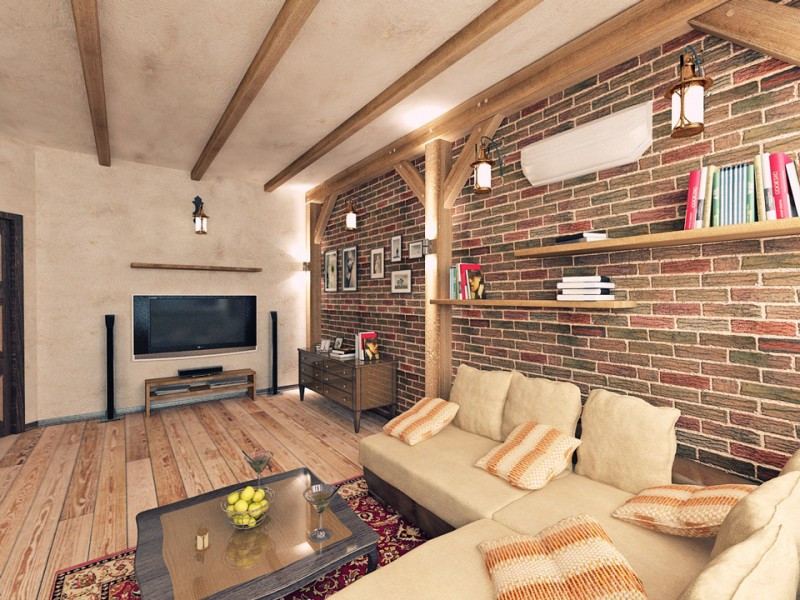 Although chalet design is traditionally associated with country houses, it can be successfully adapted for urban apartments, creating a cozy corner of Alpine comfort in an urban environment, while preserving the magic of natural materials.
Although chalet design is traditionally associated with country houses, it can be successfully adapted for urban apartments, creating a cozy corner of Alpine comfort in an urban environment, while preserving the magic of natural materials.
Practical recommendations for adapting mountain style in apartment interiors:
- Selective use of materials: Instead of fully covering walls with wood, use wooden panels on one accent wall or in a niche. This will save space and create the desired impression.
- Imitation of architectural elements: Install false beams on the ceiling (even in rooms with low ceilings, one or two horizontal beams can be placed).
- Fireplace alternative: If installing a real or bio fireplace is impossible, use an electric one with a realistic flame effect or create a decorative niche with candles.
- Compact furniture: Choose smaller furniture with characteristic country-style elements (carvings, natural materials). Prefer multifunctional items.
- Emphasis on textiles: Use wool throws, natural carpets, pillows with Alpine patterns to create an Alpine hut atmosphere without structural changes in the apartment.
- Visual techniques: Wallpaper with mountain landscapes in the interior, panoramic photographs of the Alps in natural wood frames will create the illusion of being in the mountains.
- Lighting: Use warm light (2700-3000K) and multi-level lighting to create a cozy country house atmosphere in urban conditions.
When adapting a wooden interior for an apartment, it's important to avoid overloading the space. Unlike spacious country houses, in urban conditions, it's better to use the principle of "less, but better quality," choosing a few key style elements instead of trying to recreate it completely, while maintaining the mysterious charm of mountain cottages in miniature.
For inspiration and specific ideas for adapting chalet architecture in urban interiors, refer to collections of modern design solutions that demonstrate how to functionally integrate Alpine style elements into limited space.
Economical Solutions for Modern Chalets
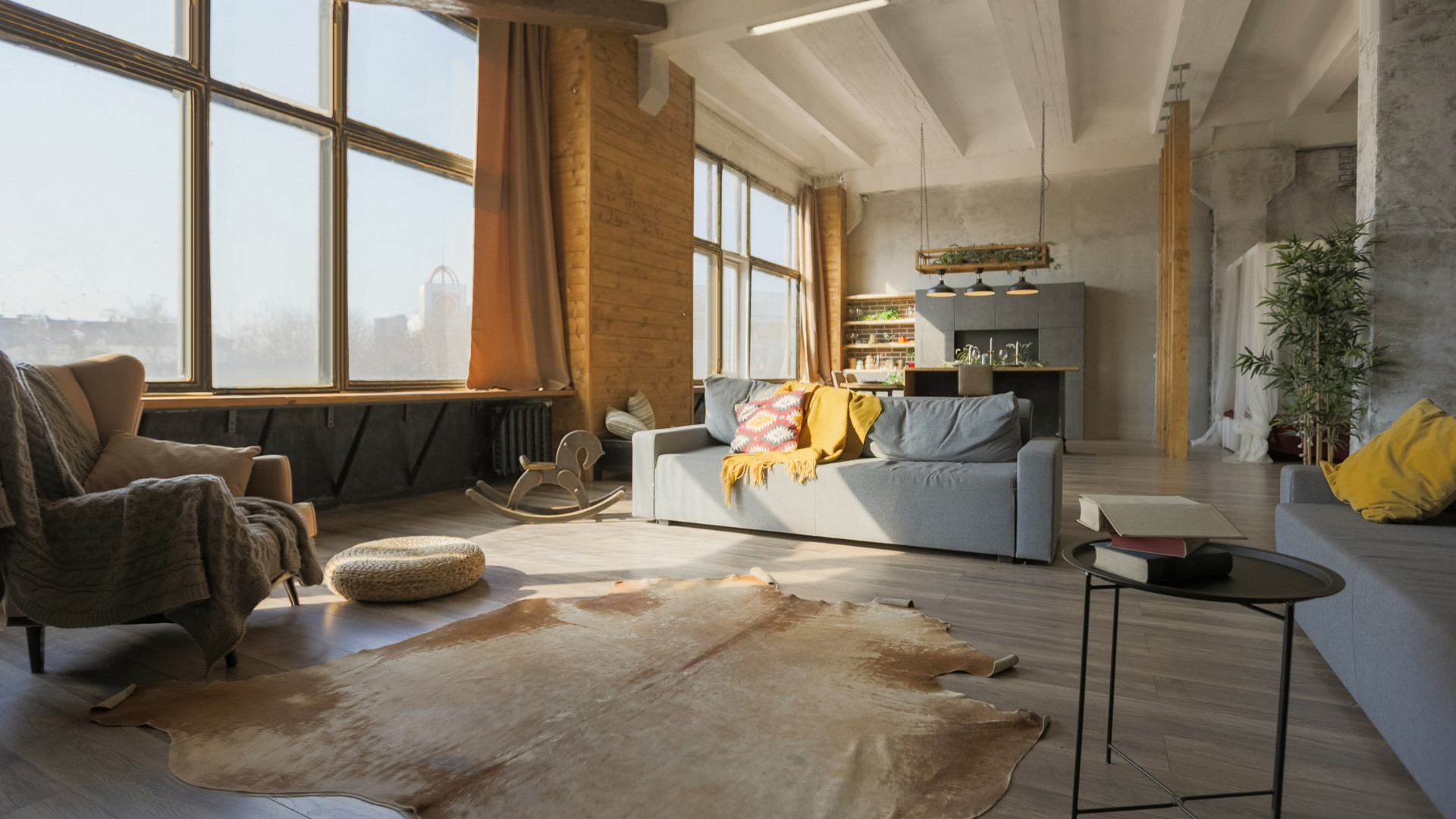 Creating an interior in mountain style doesn't necessarily require large investments. There are reasonable alternatives to expensive materials and techniques that allow achieving an authentic look without significant costs, which is especially relevant if you're interested in chalet-style renovation with a limited budget.
Creating an interior in mountain style doesn't necessarily require large investments. There are reasonable alternatives to expensive materials and techniques that allow achieving an authentic look without significant costs, which is especially relevant if you're interested in chalet-style renovation with a limited budget.
Practical tips for creating a budget interior in a Swiss chalet:
- Wall finishing: Instead of solid wood, use MDF wall panels with "wood-look" lamination or pine tongue and groove with tinting.
- Ceiling beams: Polyurethane or polystyrene imitations of wooden beams are visually indistinguishable from real ones but significantly lighter and cheaper to install.
- Flooring: High-class wear-resistant laminate (class 32-33) with deep embossing of the "wood-look" surface or vinyl planks (SPC) look dignified and are practical in use.
- Fireplace: An electric hearth in a decorative stone portal is an affordable alternative to a real fireplace, not requiring complex installation and approvals.
- Furniture: Restoration of vintage furniture or acquisition of basic models with subsequent refinement (aging, decorating). Also consider pine furniture — the most affordable wood option.
- Textiles: Products made from natural materials can be found at sales or custom-made from inexpensive fabrics (linen, cotton) to individual sizes.
- Decor: Use items found at flea markets, in antique shops, or handmade. Dry branches, pine cones, stones collected during walks can become free decor elements.
- Lighting: Modern LED bulbs with warm light (2700K) are significantly more economical in operation. Simple fixtures can be modified by adding forged elements and wooden details.
It's important to remember that Bavarian and Norwegian styles value simplicity and functionality, so even with a limited budget, an authentic atmosphere can be created by focusing on the main characteristic elements and avoiding excessive decor. The advantage of this approach is that chalet house construction can be carried out in stages, distributing costs over time.
Seasonal Changes in Chalet Interior
One of the advantages of chalet style is its adaptability to different seasons. Small changes in textiles and decor allow updating the interior according to the time of year, creating a comfortable atmosphere and optimal functionality for each season.
| Season | Textiles | Decor | Functional Elements |
|---|---|---|---|
| Winter | Thick wool throws, fur throws on chairs, flannel bed linen, high-pile carpets | String lights with warm light, candles in massive candlesticks, compositions of fir branches, decorative sleighs | Warm pillows with buckwheat husk filling, foot warmers, firewood stands next to the fireplace |
| Spring | Lighter cotton or linen throws, textiles with natural patterns, light throws on pillows | Live plants in wooden planters, compositions of spring flowers, decorative bird nests | Seasonal replacement of curtains with lighter ones, additional ventilation, aromatic diffusers with fresh scents |
| Summer | Minimal textiles: light curtains, cotton napkins, thin throws for cool evenings | Bouquets of wildflowers, dried flower compositions, natural minerals, decorative boats | Natural cooling elements (stones, fountains), shading systems for windows, mosquito nets |
| Autumn | Medium-density wool and cotton throws, textiles in warm tones, plaid patterns | Compositions of dry leaves and berries, pumpkins, fruit baskets, clay vases with autumn branches | Preparation of the fireplace for the winter season, window insulation, introduction of additional light sources |
Seasonal changes in modern chalet interiors not only refresh the space but also have practical value, helping to adapt the home to temperature fluctuations and changing needs. Small investments in seasonal decor and textiles allow maintaining interest in the interior and maximizing comfort throughout the year.
Success Story: A Functional Chalet for a Family with Children
The Martens family from Belgium always dreamed of a chalet-style house, but they were concerned about the practicality of such an interior for everyday life with three children and pets. In 2021, they decided on a complete chalet-style reconstruction of their two-story house with an area of 185 sq. m, aiming to combine authentic Alpine style with high functionality.
The project began with careful planning: materials for the chalet were chosen that are resistant to intensive use but preserve the aesthetics of mountain style in the interior. For the floor, they used engineered board with increased moisture resistance and scratch protection. The walls were partially finished with wooden panels with protective varnish coating, allowing easy cleaning of surfaces.
Special attention was paid to furniture for the chalet interior: instead of light upholstery, they chose leather and dark fabrics that mask possible stains. Sofas were equipped with removable covers for washing. A well-thought-out storage system — built-in wardrobes, chests, multifunctional poufs — helped organize the space and quickly clean up children's toys, preserving the fairy-tale atmosphere of Swiss cottages.
The most complex element was the interior fireplace. The family chose a closed stove with protective glass preventing children's contact with fire and installed additional protective fencing. The area around the fireplace was paved with porcelain tiles, resistant to high temperatures and easy to maintain.
Today, after three years of intensive use, the Alpine house maintains its attractiveness and functionality. "At first, we were worried that the chalet style would be too demanding in maintenance, but properly selected materials and well-thought-out solutions made our house not only beautiful but also practical. The children adore our 'mountain hut,' and we enjoy the authentic atmosphere without unnecessary hassle," — shares Eliza Martens, demonstrating that chalet-style finishing can be durable even in actively used spaces.
What are the pros and cons of chalet houses?
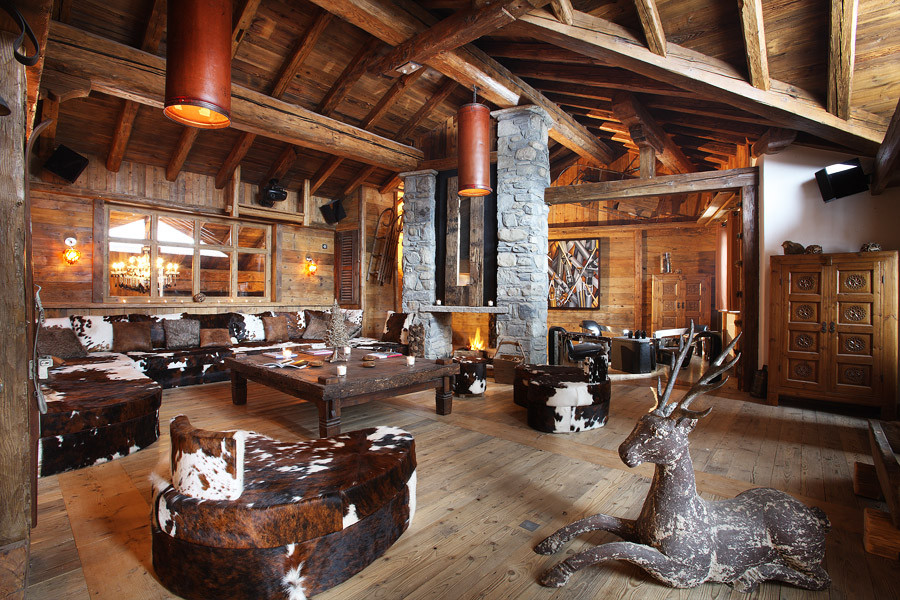 Among the advantages of chalet-style houses: high eco-friendliness thanks to natural materials, excellent thermal insulation, unique cozy atmosphere, durability of construction, and timeless design. Disadvantages include the high cost of quality materials (which is reflected in the overall price — chalet house price is often above average), complexity in caring for wooden elements, the need for regular maintenance of natural materials, and limited possibilities for technological innovations without violating the style. However, durability and eco-friendliness make this style economically advantageous in the long term.
Among the advantages of chalet-style houses: high eco-friendliness thanks to natural materials, excellent thermal insulation, unique cozy atmosphere, durability of construction, and timeless design. Disadvantages include the high cost of quality materials (which is reflected in the overall price — chalet house price is often above average), complexity in caring for wooden elements, the need for regular maintenance of natural materials, and limited possibilities for technological innovations without violating the style. However, durability and eco-friendliness make this style economically advantageous in the long term.
Alpine style in interior design is not just a design solution, but an entire philosophy of life based on closeness to nature, functionality, and coziness. When creating a design in the spirit of Alpine huts, it's important to maintain a balance between authenticity and practicality, choosing materials and solutions that will serve for many years. Regardless of the size of your home and budget, a competent approach to adapting mountain style in the interior will allow you to create a space where every element is not only beautiful but also functional.
Even small touches — quality textiles in the chalet, well-thought-out lighting, natural materials — can bring a piece of Alpine coziness into your home, creating a place where you want to spend time with loved ones, enjoying peace and warmth. Using the recommendations from this guide will help you avoid common mistakes when building a chalet and create a truly practical and inspiring interior in Swiss chalet style, preserving the magic of handcrafted details.
